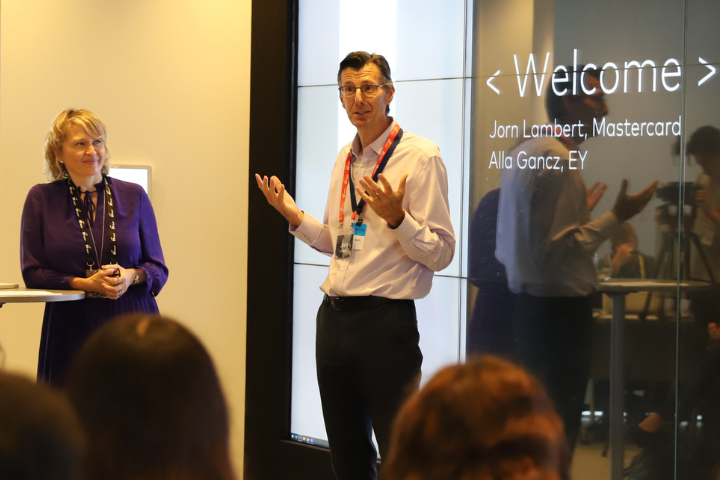Buying a home or leasing heavy machinery with … blockchain? These innovators pitched the potential of the tech
September 20, 2023 | By Joshua Farrington
“Buying a home is one of the most stressful moments in your life — having to get on the phone and confirm that you’re moving a huge amount of money from your account to someone else’s account. There has to be a better way of doing things.”
John Reynolds, the chief operating officer of the property transaction business Coadjute, stood before more than 100 people gathered high above London’s Canary Wharf to explain how the use of blockchain technologies is enhancing familiar but complex processes, like buying a home. There are many stakeholders in any property transaction, all using different systems and working in different ways, Reynolds said. “An escrow account on the blockchain … would allow for clear and transparent transfer of funds, giving all the parties a single, simple infrastructure to work from.”
Finding a better way of doing things with tokenized deposits on a blockchain – that’s what drew all these people together for Mastercard’s first-ever Innovation Sprint, proposing exciting new use cases across sectors including global supply chains, real estate, carbon markets, small-business financing and international aid by using Mastercard Multi-Token Network. Everything from buying a home to leasing heavy machinery or sourcing carbon credits could be transformed by the opportunities presented by payments powered by blockchain technologies — as long as that potential is guided by industry collaboration and strict standards of trust, said Jorn Lambert, Mastercard’s chief digital officer.

Mastercard's Jorn Lambert, above, says digital asset innovation has the potential to unleash great efficiencies in financial services.
Mastercard Multi-Token Network is a set of tools and standards that have been built on a private, secure chain, enabling bank deposits to power innovative new business models across several sectors – a capability that was not previously possible. Mastercard believes blockchain is so much more than crypto: The distributed ledger technology can create a foundation of security, interoperability and scalability that can encourage more mainstream consumers and regulated financial institutions to modernize their systems and innovate.
“The power of technology can bring enormous efficiency to any space of economic activity,” Lambert said at the opening of the event. “With the right building blocks,” he added, “the digital assets ecosystem can power the next financial services innovation.”
The Innovation Sprint attracted more than 60 submissions from players ranging from major banks to large corporations to emerging startups, with 14 blockchain concepts presented to a panel of industry experts throughout the day.
Santander, for example, showcased its concept of smart contracts created on the blockchain, which could prove more secure than traditional account-to-account payments that can be targeted for fraud.
Many of the concepts on display looked to tackle the friction burdening international trade and global supply chains. The delivery documents that shippers and carriers use and that form the basis of global trade have essentially remained unchanged since the 1600s, often still written out and processed by hand, pointed out Kene Ezeji-Okoye, co-CEO of digital finance developer Millicent Labs. This process is de-linked from the payment and acts as an enormous bottleneck and source of risk to the entire supply chain. NFTs swapped for tokenized deposits on the other hand, mean that payments can be integrated with digital and trackable versions of these paper documents, building speed and efficiency into the system.
Senken is a marketplace for climate assets such as carbon credits, which allow companies to offset their carbon emissions. The company outlined a plan to use Mastercard Multi-Token Network to facilitate instant payments of tokenized carbon credits using tokenized bank deposits. Currently, the carbon market is often perceived to be complex, lacking in consistency and transparency and with an inadequate payment experience for market participants. This cloaks the market in obscurity, with a significant portion of funds siphoned off by middlemen, said Josep Coronado, Senken’s head of product.
In his pitch, Coronado said that by using Mastercard Multi-Token Network, carbon credit buyers could transact direct from their standard bank accounts, not only making the blockchain-enabled carbon market more investor-friendly, but retaining the benefits of tokenized carbon credits: increased transparency, improved operational efficiency, and bolstered investment trust and confidence.
Another unique showing came from international aid marketplace Coala Pay, which is already part of Mastercard’s Start Path Digital Assets startup engagement program. Money movement for humanitarian aid is currently impacted by high fees and currency fluctuations, but founder Melyn McKay illustrated how the network could insulate donor funds from these risks, ensuring more money gets to where it’s needed most.
“Mastercard Multi-Token Network isn’t just built to serve a single sector of the economy,” said Martin Etheridge, a senior vice president of Mastercard’s blockchain and digital assets team. “At this innovation sprint, we’ve seen presentations from banks, startups, even heavy industrials. We’ve long expected the use of blockchain to reach significant scale – and it’s happening now.”
Participating companies in the Mastercard Multi-Token Network Innovation Sprint included Coala Pay, Coadjute, FSCO (Fresh Supply Co), Inveniam, Millicent Labs, Pakt, Polytrade, Re, Santander, Senken, Streamba, Vayana and Vodafone. Banner image: Melyn McKay of Coala Pay.